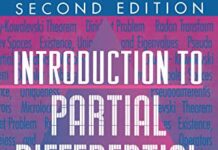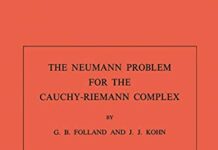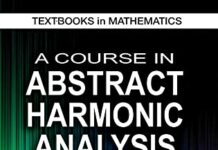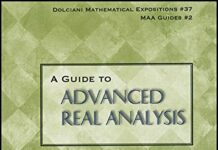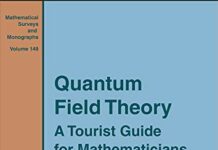
Ebook Info
- Published: 2013
- Number of pages: 406 pages
- Format: PDF
- File Size: 7.94 MB
- Authors: Gerald B. Folland
Description
An in-depth look at real analysis and its applications-now expanded and revised. This new edition of the widely used analysis book continues to cover real analysis in greater detail and at a more advanced level than most books on the subject. Encompassing several subjects that underlie much of modern analysis, the book focuses on measure and integration theory, point set topology, and the basics of functional analysis. It illustrates the use of the general theories and introduces readers to other branches of analysis such as Fourier analysis, distribution theory, and probability theory. This edition is bolstered in content as well as in scope-extending its usefulness to students outside of pure analysis as well as those interested in dynamical systems. The numerous exercises, extensive bibliography, and review chapter on sets and metric spaces make Real Analysis: Modern Techniques and Their Applications, Second Edition invaluable for students in graduate-level analysis courses. New features include: * Revised material on the n-dimensional Lebesgue integral. * An improved proof of Tychonoff’s theorem. * Expanded material on Fourier analysis. * A newly written chapter devoted to distributions and differential equations. * Updated material on Hausdorff dimension and fractal dimension.
User’s Reviews
Reviews from Amazon users which were colected at the time this book was published on the website:
⭐This is the second time I’ve re-reviewed this book.First off, I am not a mathematician. I was trained as an engineer, and have recently started studying more advanced mathematics to apply it to my research. The only undergrad math course I’d taken before using this book was the standard analysis course. I initially used this book for a first graduate course in real analysis. Even with a professor, going through the book was incredibly difficult, and I had to resort to another book (Wheeden and Zygmund) as well as extensive notes provided by the professor. This experience made me loathe the book.A few months after the course, having gained more exposure in this area, I returned to the book, and was surprised to find that I had finally started to understand why the author had organized it the way he had. Now, 6 months and another grad course in analysis later (operator theory), I think the book is worth its weight in gold.First off, let’s outline the cons. At first sight, the book takes brevity to the brink of lunacy. A (very) respectable first graduate course in analysis is covered in the first 100 pages. Dense doesn’t even begin to cover it. Major results are relegated to the exercises, whole topics are compressed into a section (sometimes two or three are crammed into one), and even the proofs are presented with the barest minimum of explanation. The whole book is about 370 pages, and has enough material for about 4-5 courses. The exercises range from doable to extremely difficult. You also have chapters on everything from point set topology to harmonic analysis (abstract and otherwise) to probability to functional analysis. Heck, even fractals and manifolds pop up by the end.The truth, however, is that all of these cons are actually pros in disguise. I know most engineers secretly think that the word ‘elegant’ used to describe mathematics textbooks is basically code for ‘stupendously bad exposition’, but the simple truth is this: analysis is hard. Sometimes brutally so, and the more you beat your brains against it, the better. If you’re looking for a quick and easy explanation of the Lebesgue integral, this really isn’t your book. Especially if you’re not used to thinking as abstractly as is required here (I certainly wasn’t).I freely admit that I wouldn’t recommend this as a first textbook to my worst enemies (my worst enemies are other engineers). But for mathematicians, the brevity might actually be useful. And once you know the basic material (the first three chapters), the book becomes an invaluable resource.
⭐This book does not provide a lot of detail. At first this made me very annoyed, but if you are going to be successful in mathematics, you need to be able to work out details on your own to convince yourself of arguments. Folland leaves a lot of room for you to do this. Also, a lot of people seem to be complaining about the typos, yes there does seem to be an abnormally large amount of typos, but again, spotting these is a skill you will need to be successful in research mathematics. Not everything you read is going to be in final draft form with all the typos gone.Two more things:1. if you have baby rudin, read the last chapter before/with the introductory material of this book and some things may be much more clear.2. the book is in my opinion WAY too expensive.
⭐This is a very expensive book that is poorly conceived, poorly executed and even poorly manufactured. Its in the tradition of Rudin’s “lemma, theorem, proof, corollary” ad nauseum without providing any insight, motivation or even enthusiasm for analysis. The proofs are obviously copied and cobbled together with a hammer from other books with obnoxious simplifications which are counterproductive – apparently the author just wanted to cram as many as possible theorems into this little libellus, at the expense of quality. I would say avoid this book but unfortunately its in vogue right now and is a required text in many undergraduate (or even graduate) classes. Use the book gently and then sell it right after the class to recover some of the money.
⭐The best book for learning analysis.
⭐I first encountered this textbook when I used it to study for the analysis prelim at UT the summer after my first year of graduate school. I had been studying Rudin’s Real and Complex Analysis during the semester, and while Rudin is elegant and beautiful, this book is far more comprehensive and, most importantly to me, systematic. From the very beginning, Folland develops the theory of Borel measures on the real line in generality (whereas Rudin’s “construction” of Lebesgue measure based on the Riemann integral is, in my opinion, incomprehensible). The treatment of general measure theory in this book is worth the purchase price on it’s own, but Folland includes lots of material going well beyond the standard course on measure theory and integration. The most valuable chapters non-measure-theoretic chapters for me are the ones covering point set topology and the rudiments of functional analysis (Hilbert and Banach spaces, and a little bit about general topological vector spaces, but not much).Graduate school is now behind me, but Folland’s book continues to be my favorite reference for analysis and even point set topology. Admittedly I have not looked for analysis books in many years, but that’s because Folland has met all my needs (in the interest of full disclosure I should say I’m a number theorist, not an analyst, but for what I do a good knowledge of analysis is essential).If you’re interested in the book to supplement a course in measure theory and abstract real analysis, or for self-study, I would say that the only background knowledge is the material in a standard undergraduate introduction to real analysis (perhaps sticking to metric space topology and treating Riemann integration rigorously). More important for reading the book is a capacity to understand and appreciate abstraction, and a reasonable level of mathematical maturity. I took an undergraduate course in general topology (using Munkres) which covered the material in Folland (most of it anyway) over the course of a semester, and I think this did more to prepare me for Folland (and advanced mathematics in general) than any other course I took. If you are comfortable reading and writing proofs (general topology being an excellent subject with which to cultivate these skills), then I think you will enjoy and learn a great deal from Folland’s book.
⭐This book is very difficult, but awesome. Folland’s point of view is really abstract and clean. One sentence that symbolize the book, for me, is: “…measurable mappings, which are the morphisms in the category of measurable spaces”. The author uses a really high mathematical language, but this helps to focus on concepts understanding the real meaning.Not advised for introductory courses, it’s better for a second reading. There is a lot of material inside: Measure theory, Point Set Topology, Functional Analysis, Fourier Analysis, Distributions, Probability and more. It can be used in a lot of graduated courses.In the last part there is a nice paragraph on a measure theory approach to integration on Riemannian manifolds.The only downside is the price, but it finally deserves it.
⭐Too expensive for what you get. Cheep paper, bad printing definition, cheep binding. I can’t imagine that Folland’s excellent work has been disrespected this way. Because I believe he is not getting much money from here, so it raises the question why the people who is getting this absurd amount of money for a book it’s not wheeling to captive their costumers. Para un libro de 3,500 la calidad es terrible. No sean “marros” e impriman bien las cosas o dedíquense a otra cosa; éste no es su negocio.
⭐Libro meraviglioso e ricco di contenuti. Dalla teoria della misura alle sue apllicazioni in probabilità e statistica. Assolutamente da comprare.
⭐
⭐I used Folland’s Real Analysis for my undergraduate Real & Functional Analysis course at UBC. The writing style is clear and the proofs are neat. It’s my favorite analysis textbook so far.
Keywords
Free Download Real Analysis: Modern Techniques and Their Applications (Pure and Applied Mathematics: A Wiley Series of Texts, Monographs and Tracts Book 125) 2nd Edition in PDF format
Real Analysis: Modern Techniques and Their Applications (Pure and Applied Mathematics: A Wiley Series of Texts, Monographs and Tracts Book 125) 2nd Edition PDF Free Download
Download Real Analysis: Modern Techniques and Their Applications (Pure and Applied Mathematics: A Wiley Series of Texts, Monographs and Tracts Book 125) 2nd Edition 2013 PDF Free
Real Analysis: Modern Techniques and Their Applications (Pure and Applied Mathematics: A Wiley Series of Texts, Monographs and Tracts Book 125) 2nd Edition 2013 PDF Free Download
Download Real Analysis: Modern Techniques and Their Applications (Pure and Applied Mathematics: A Wiley Series of Texts, Monographs and Tracts Book 125) 2nd Edition PDF
Free Download Ebook Real Analysis: Modern Techniques and Their Applications (Pure and Applied Mathematics: A Wiley Series of Texts, Monographs and Tracts Book 125) 2nd Edition
